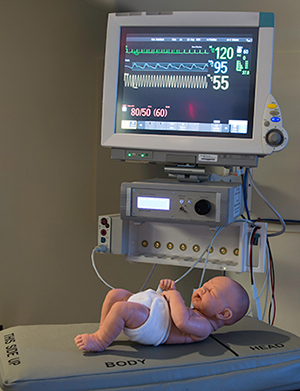Collaboration between researchers at Harvard's Wyss Institute and clinicians at Beth Israel Deaconess Medical Center and the University of Massachusetts Medical School led to a technology that prevents apnea in newborns

(BOSTON) — Scientists, engineers and clinicians at the Wyss Institute for Biologically Inspired Engineering at Harvard University and its collaborating institutions, the Beth Israel Deaconess Medical Center (BIDMC) and the University of Massachusetts Medical School (UMMS), have shown in a clinical trial in the BIDMC neonatal intensive care unit (NICU) that their new prevention technology reduces apneic events and improves critical clinical parameters in preterm infants. The findings are reported in the November 23 issue of Pediatrics.
“Apneic breathing and its associated risks is a major challenge in NICUs today, which can also lead to prolonged and expensive hospital stays. This prompted us to develop a non-invasive, non-pharmacological solution that can address the immature respiratory control in these preterm infants,” said David Paydarfar, M.D., a Wyss Institute Associate Faculty member and a Professor at UMMS, who was the scientific lead on the apnea prevention program. While others were focused on the moment a baby stops breathing, Paydarfar and his team at UMMS, were investigating how to prevent apnea from occurring in the first place.
Key to the infant apnea prevention technology is the principle of ‘stochastic resonance’ early work by the Wyss Institute’s Core Faculty member James Collins, Ph.D., revealed the counterintuitive phenomenon in which application of a small amount of random vibratory stimulation or “noise” to a complex biological system, such as the human body, increases the sensitivity of that system. Collins is also the Termeer Professor of Medical Engineering & Science at the Massachusetts Institute of Technology (MIT) and a Professor of Biological Engineering at MIT.
Paydarfar applied this principle to the problem of apnea of prematurity. In an early pilot study done at UMMS, Paydarfar and his colleagues showed that adding “noise” in the form of a subtle vibration in the mattresses of preterm infants helps to stabilize their breathing and improve blood oxygenation without waking the infant. This suggested that a stochastic resonance approach could compensate for the immaturity of the preterm infants’ respiratory control system, and thereby prevent dangerous apneic events from occurring.
“Our team subsequently developed a new mattress device designed to deliver the same level of therapeutic vibration that was found to be effective in Paydarfar’s previous studies while limiting the vibrations that would otherwise be delivered to the head of the infant to further protect the developing brain from any potential undesired effects,” said John Osborne, a Senior Staff Engineer at the Wyss Institute who helped to develop the new therapeutic mattress technology and co-led authorship on the publication.
The team has now validated this new mattress device in the BIDMC trial, studying a cohort of 36 preterm infants that had at least one previous event of apnea. The results of the trial provide comprehensive clinical evidence for the method’s ability to benefit breathing stability.
“We tested the effects of the therapeutic mattress vibrations within each infant by comparing the 30-minute periods when the vibrations were ‘on’ to the 30-minute periods when the vibrations were ‘off’. With this approach, we saw a reduction in the incidence of apnea by 50%, and, perhaps equally important, we ameliorated every clinically significant aspect of oxygen desaturation events as well as decreased the severity of bradycardia events. These effects were in addition to any caffeine effects. The technology therefore might be used as a stand-alone or as a supplement to the caffeine therapy with which many preterm infants are commonly treated,” said Vincent C. Smith, M.D., M.P.H., Assistant Professor of Pediatrics at Harvard Medical School and Associate Director of the BIDMC’s NICU who is also lead author on the published study.
“It has been exciting to watch this apnea prevention technology go from concept to prototype and onward to successful demonstration of efficacy in a human clinical trial. These findings exemplify once again the power of our translation engine here at the Wyss Institute, and how we can quickly develop and validate solutions for important clinical problems,” said Wyss Institute Founding Director Donald Ingber, M.D., Ph.D., who also is the Judah Folkman Professor of Vascular Biology at Harvard Medical School and Boston Children’s Hospital, and Professor of Bioengineering at the Harvard John A. Paulson School of Engineering and Applied Sciences.